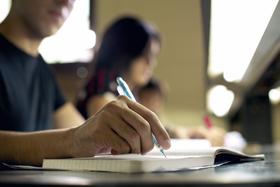For the 2025-26 school year, there are 3 public high schools serving 608 students in Devine Independent School District. This district's average high testing ranking is 6/10, which is in the top 50% of public high schools in Texas.
Public High Schools in Devine Independent School District have an average math proficiency score of 38% (versus the Texas public high school average of 38%), and reading proficiency score of 48% (versus the 47% statewide average).
Public High School in Devine Independent School District have a Graduation Rate of 95%, which is more than the Texas average of 90%.
The school with highest graduation rate is Devine High School, with ≥95% graduation rate. Read more about public school graduation rate statistics in Texas or national school graduation rate statistics.
Minority enrollment is 69% of the student body (majority Hispanic), which is less than the Texas public high school average of 74% (majority Hispanic).
Overview
This School District
This State (TX)
# Schools
6 Schools
2,543 Schools
# Students
1,984 Students
1,863,601 Students
# Teachers
130 Teachers
125,439 Teachers
Student-Teacher Ratio
15:1
15:1
Student By Grade
District Rank
Devine Independent School District, which is ranked #665 of all 1,196 school districts in Texas (based off of combined math and reading proficiency testing data) for the 2022-2023 school year.
The school district's graduation rate of 95% has stayed relatively flat over five school years.
Overall District Rank
#663 out of 1202 school districts
(Bottom 50%)
(Bottom 50%)
Math Test Scores (% Proficient)
39%
44%
Reading/Language Arts Test Scores (% Proficient)
49%
51%
Science Test Scores (% Proficient)
45%
46%
Graduation Rate
(21-22)≥95%
90%
Students by Ethnicity:
Diversity Score
0.47
0.64
% American Indian
n/a
n/a
% Asian
n/a
5%
% Hispanic
66%
53%
% Black
1%
13%
% White
32%
26%
% Hawaiian
n/a
n/a
% Two or more races
1%
3%
All Ethnic Groups
District Revenue and Spending
The revenue/student of $12,040 in this school district is less than the state median of $13,398. The school district revenue/student has stayed relatively flat over four school years.
The school district's spending/student of $10,572 is less than the state median of $14,129. The school district spending/student has stayed relatively flat over four school years.
Total Revenue
$24 MM
$74,029 MM
Spending
$21 MM
$78,063 MM
Revenue / Student
$12,040
$13,398
Spending / Student
$10,572
$14,129
Best Devine Independent School District Public High Schools (2025-26)
School
(Math and Reading Proficiency)
(Math and Reading Proficiency)
Location
Quick Facts
Rank: #11.
Devine High School
(Math: 35-39% | Reading: 50-54%)
Rank:
Rank:
6/
Top 50%10
1225 W Hondo
Devine, TX 78016
(830) 851-0895
Devine, TX 78016
(830) 851-0895
Gr: 9-12 | 575 students Student-teacher ratio: 15:1 Minority enrollment: 69%
Rank: #22.
Devine Daep School
Alternative School
(Math: ≤20% | Reading: ≤20% )
Rank:
Rank:
1/
Bottom 50%10
205 W College
Devine, TX 78016
(830) 851-0795
Devine, TX 78016
(830) 851-0795
Gr: 8-11 | 6 students Student-teacher ratio: 6:1 Minority enrollment: 83%
Rank: n/an/a
Devine Learning Academy
Alternative School
205 W College
Devine, TX 78016
(830) 851-0711
Devine, TX 78016
(830) 851-0711
Gr: 9-12 | 27 students Minority enrollment: 74%
Recent Articles

School Vouchers: Updated Pros and Cons (2025 Review)
Comprehensive 2025 analysis of school vouchers, weighing benefits and challenges for families, funding, outcomes, and policy directions.

Benefits and Drawbacks of Homework in 2025
Explore updated 2025 insights on homework’s benefits, drawbacks, mental health impact, best practices, and policy trends in U.S. public schools.

Charter Schools vs Public Schools 2025: Key Differences & Trends
Explore updated 2025 insights comparing charter schools vs public schools, enrollment, academic outcomes, funding, and real-world examples for families and educators.





